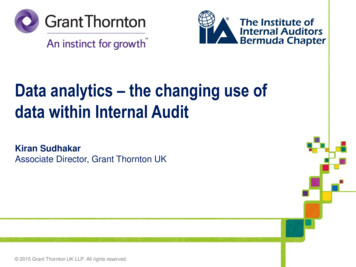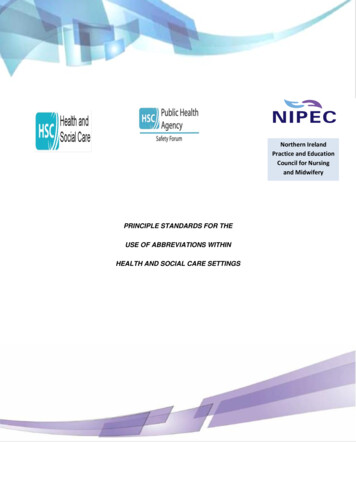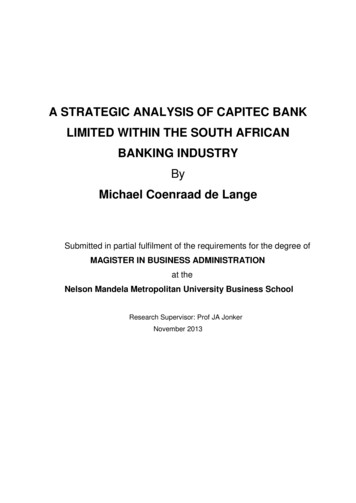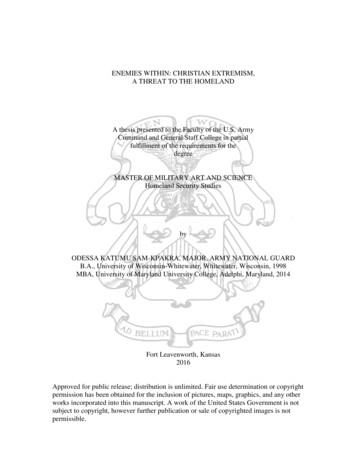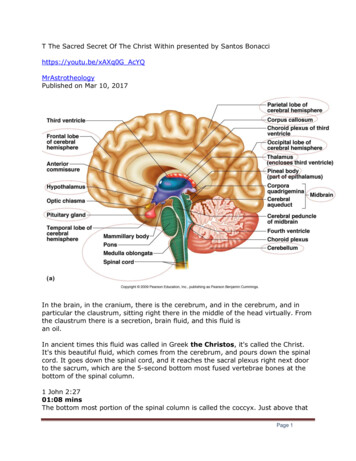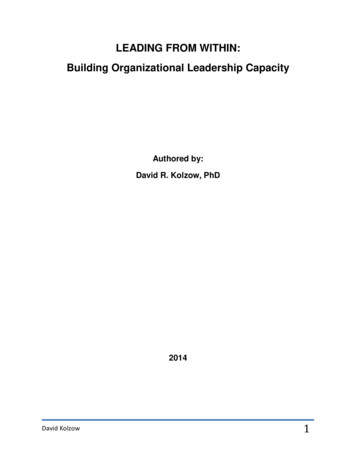
Transcription
LEADING FROM WITHIN:Building Organizational Leadership CapacityAuthored by:David R. Kolzow, PhD2014David Kolzow1
7EADING FROM WITHIN:BUILDING ORGANIZATIONAL LEADERSHIP CAPACITYTable of ContentsPage #Chapter 1: IntroductionChapter 2: What Does It Mean to be a “Leader?”Leadership DefinedLeadership in TransitionChapter 3: Understanding the Foundations of LeadershipLeadership ModelsLeadership Trait TheoryLeadership Behavior TheoryContingency Theory and Situational Leadership TheoryChapter 4: What’s Your Leadership Style?Authoritarian vs. Democratic LeadershipPower and LeadershipThe Charismatic LeaderTransactional LeadershipTransformational LeadershipThe Servant LeaderSituational LeadershipConclusions About Leadership StylesChapter 5: Demonstrating Effective LeadershipLeadership CharacterLeadership BehaviorBeing Self-directedAction- and results-orientedCommunicationRespecting and caring for othersWillingness to take risks and be innovativeTransparencyRighting wrongsStaying focusedResponding quickly with agilityA positive attitudeClarityChapter 6: Critical Leadership Competencies - What Makesa Successful Leader?IntroductionDavid 973757778828588919293949597972
Possess clarity of directionHas the ability to inspire others to high performanceCommunicates well and listens intensivelyDemonstrates a collaborative orientationWorks to develop peopleHas the ability to think creativelyPossesses intelligence and learning agilityIs capable of creating a culture of excellencePractices consistent disciplineDelivers resultsClarifies expectationsPractices accountabilityExercises good judgmentConclusionsChapter 7: Learning Leadership SkillsHard vs. Soft SkillsInterpersonal SkillsCommunicate EffectivelyConflict ResolutionNegotiationProblem-Solving and Critical ThinkingDecision-MakingFacilitationChapter 8: Leadership and Dealing with ChangeThe Reality of ChangeLeader’s Role in Change ManagementOrganizational ChangeChange Leadership vs. Change ManagementFacilitating ChangeThe Board and ChangeChapter 9: The Visionary LeaderEnvisioningStrategic ThinkingChapter 10: The Leader as EnablerEmpowermentCoachingCollaborationChapter 11: Building Leadership Capacity in the OrganizationLevels of Leadership in the OrganizationWho Are the Organization’s Potential Leaders?Building Volunteer Leaders in the OrganizationHow Do We Train New Leaders?Chapter 12: The Economic Development Professional as Leaderand ManagerLeader vs. ManagerLeadership and AccountabilityDavid 2512542552592642682682732772822952983023
Facilitator and Consensus-BuilderThe Practitioner as EducatorThe Economic Developer as Community LeaderChapter 12: ConclusionsBibliographyDavid Kolzow3053063073103114
Chapter 1INTRODUCTIONSo why another book on leadership? Literally, hundreds of books on thistopic grace the shelves of bookstores and libraries. Communities across thenation offer annual training programs to improve civic leadership. Variousstate and local governments send their staff through leadership classes.Corporate training programs focus on leadership development.Leadership courses abound in adult education. And so on.The premise of this book is that despite all the attention to leadershipdevelopment, nonprofit community and economic developmentorganizations and government agencies could benefit from a more directedand structured program to develop effective leaders within andthroughout their organization and thereby improve the quality of theiroperation. Studies have consistently demonstrated that organizations thatprioritize leadership development are much more effective in meeting theexpectations of their constituents, stakeholders, and customers. It has beensaid that the better the leadership, the better the organization is ablecollectively to ride the challenges of difficult times.1According to Bersin & Associates study entitled “High-Impact LeadershipDevelopment” (2008), an organizational focus on leadership developmentresults in: Becoming 84 percent more effective at raising the quality of theleadership “pipeline;” A 73 percent increase in employee retention; A 67 percent increase in the ability of the organization’s members towork collaboratively; and, A 66 percent improvement in the organization’s results.According to the 2008 IBM Global Human Capital Study, over 75 percent ofthe respondents identified building leadership talent as their current and1Ken Sundheim, “Defining , Improving and Teaching Leadership With Those Who Know It Best,Forbes.com, 10/28/2013.David Kolzow5
most significant capabilities challenge. Leaders today sometimes appear tobe an endangered species. The second most important capacity buildingchallenge facing organizations in this study was fostering a culture thatsupports learning and development. Clearly, these two key challenges areclosely related.Leadership, like the inner workings of a computer, is a complex set ofrelationships, systems, and processes that few fully master. Dave Ulrich,Global Consulting Alliance.Organizational life today is often a complex social environment ofconfrontation, miscommunication, manipulation, hostility, and conflict.Does that sound like an exaggeration to you? If so, take a good look atmost organizations. So much of what takes place in virtually allorganizations is grounded in the interrelationships of its members, and allhuman relationships have problems. These interactions involve the workthat is done, the goals that are set, and the decisions that are made. Withouteffective leadership, members of an organization often quickly degenerateinto argument and conflict, because they each see things in different waysand lean toward different solutions.The core of the criticism of organizations in a lot of the literature is that allsorts of them (corporations, government agencies, and not-for-profitorganizations) tend to be over-managed and under-led. Thoseorganizations suffering from over-management tend to be slow to makenecessary changes and therefore achieve less than what they could. In theorganizations that are characterized by poor leadership, employees seevery little that is positive. In a climate of distrust, employees learn that socalled leaders will act in ways that are not easily understood or that do notseem to be in the organization’s best interests. Poor leadership leads to anabandonment of hope, which, if allowed to go on for too long, results in anorganization becoming completely dysfunctional. The organization mustthen deal with the practical impact of unpleasant change, but moreimportantly, must labor under the burden of employees who have givenup, and have no faith in the system or in the ability of leaders to turn theDavid Kolzow6
organization around. 2 This is a substantial criticism that points to theimportance of leadership.Although most organizations would say that they are interested inbecoming more effective and therefore more excellent, this is almostimpossible without competent leadership. Barbara Blumenthal reported inher book Investing in Capacity Building that capacity-building interventionsoften fail if strong organizational leadership is not in place.3 Thegovernment official, the agency manager, the economic developer, theChamber executive, and all staff in this new knowledge-based environmentwill need to assume the role of active networker and facilitator, both withinhis or her organization and with stakeholders and constituents. Excellencemeans that top leadership does a number of things well, including creatinga learning organization that trains and retains its talent. This is what it takesto achieve an organization that has a culture of character and integrity.A primary concern of most organizations today is the attraction andretention of talented people. However, they generally want to work forgood leaders in an open environment where they can speak their mindsfreely, be treated with respect, and where leadership promotes clarity andhonesty. Bad leaders are corrosive to an organization because they candrive out anyone who’s good. Unfortunately, since many bad leaders aremanipulative and deceptive, it is often a challenge to root them out and getrid of them. 4 The lack of positive and effective leadership is a key reasonwhy many talented workers leave the organization.Leadership is not a place; it is a process. James Kouzes and Barry Posner.Given that everyone has the capacity for leadership at some level, it wouldseem that the absence of leadership in an organization shouldn’t be aproblem. However, it isn’t likely that everyone will become a leader.Unfortunately, too many people lack the will to change or to develop tm.Barbara Blumenthal, Investing in Capacity Building: A Guide to High-Impact Approaches(Foundation Center, November 2003).4Jamie Dimon, “The Essential Hallmarks of a Good s-of-agood-leader.3David Kolzow7
leadership potential. It is often easier to “go with the flow” and be contentwith their circumstances. Even if they aren’t content, many would rathercomplain about their situation than do what is necessary to change it.Becoming a leader means having the will to pursue a path that builds thatcompetency and capacity. This path, however, is not any easy one that isquickly mastered. Most scholars agree that there is no magic bullet orsingle set of principles or behaviors that leads to effective leadership.Instead, it is becoming increasingly understood that the most effectiveleadership style in a given situation responds to what is needed. Thiscould be a function of the task required, the organization's culture, theleader's subordinates, and attributes of the leader himself/herself.Furthermore, the development of leadership is an ongoing process, not anevent or the implementation of a specific program. The complexity ofleadership and its development will be dealt with at length in this book.This is, essentially, a “how-to” and “why-to” book on developing effectiveleaders within the organization. It is not full of case studies or examples.Instead, it is a book of principles and practices meant to clarify the natureand role of building leaders and to provide a pragmatic approach foreffectively creating a higher level of organizational leadership capacity.It should be noted that there is a difference between principles andpractices. A practice is a specific activity or action, and it needs to beguided by the situation. It is therefore an action that may work in onesituation but not necessarily in another. 5 Principles, on the other hand, aredeep fundamental and timeless truths that have application to any and allorganizations, allowing them to make wise decisions. They will remaintrue and relevant no matter how the world changes.6 When these truthsare internalized into behavioral habits, they become part of our values andfoster the creation of a wide variety of practices to deal with differentsituations. 7 For example, the principle of integrity leads to a variety ofpractices that demonstrate honesty in a range of different situations.5John C. Maxwell, The 5 Levels of Leadership, New York: Center Street, 2011, p. 4.J.C. Collins. Good to Great. New York, NY: HarperCollins; 2001: pp.17–40.7Stephen R. Covey. The Seven Habits of Highly Effective People. New York: Simon & Schuster, 1989.p. 35.6David Kolzow8
This book will stress those principles and practices that lead to sustainableand positive leadership within an organization. The more we know andunderstand key principles to being an effective leader, the greater is ourfreedom to act wisely. 8 It is important to keep in mind that it takes time todevelop this wisdom that leads to the strengthening of organizationalperformance, and this work is never complete. Clearly, no “quick fixes”exist for becoming an effective leader.Chapter 2WHAT DOES IT MEAN TO BE A LEADER?Because the term “leader” or “leadership” is so frequently misused ormisunderstood, it is important that we begin by defining what these termsmean. Unfortunately, the use of the term “leader” has been popularlybroadened to include almost anyone in top management or in an electedposition.Leadership DefinedIt would appear that no one has really satisfactorily defined the concept ofleadership. One might hear it said that “I can’t really describe leadership,but I know it when I see it.” In fact, attempted definitions of leadership donot really explain leadership; they at best merely convey the essence ofleadership from a particular point of view. For example, in a typicalcommunity, the term may refer to anyone in the community who hasrelatively high visibility, such as elected officials. In an organization, itoften is used to highlight the executive director, president, and/or Boardmembers. However, a leader is certainly more than someone who is awidely recognized individual or who possesses organizational authority.8Stephen R. Covey. The Seven Habits of Highly Effective People. New York: Simon & Schuster, 1989.P. 123.David Kolzow9
Some view leadership as a series of specific traits or characteristics. Otherssee it as comprised of certain skills and knowledge. And some think ofleadership as a process that places an emphasis on social interaction andrelationships. A more encompassing perception of a leader is offered bySorenson & Epps: a forceful and dynamic personality who really leads from thefront; an architect and implementer of strategy; a mediator in conflict situations;an integrator who assures the climate of the organization; a person able to motivatesubordinates and who, by persuasion, compulsion or example to others; succeeds ingetting others to follow the leader’s wishes9. Another definition by Jo
leader's subordinates, and attributes of the leader himself/herself. Furthermore, the development of leadership is an ongoing process, not an event or the implementation of a specific program. The complexity of leadership and its development will be dealt with at length in this book. This is, essentially, a “howand “why-to” -to” book on developing effective leaders within the .
